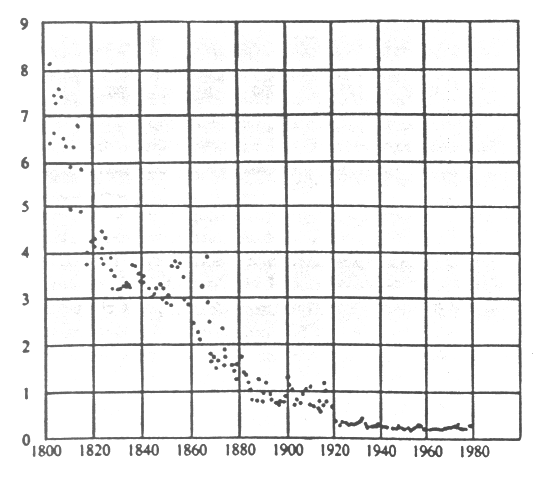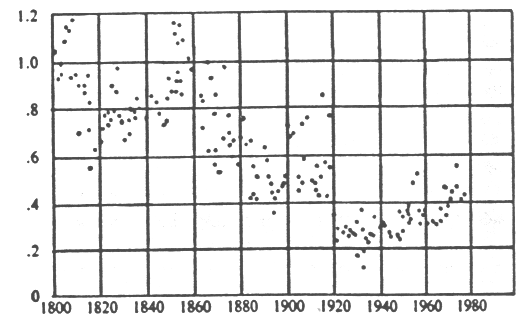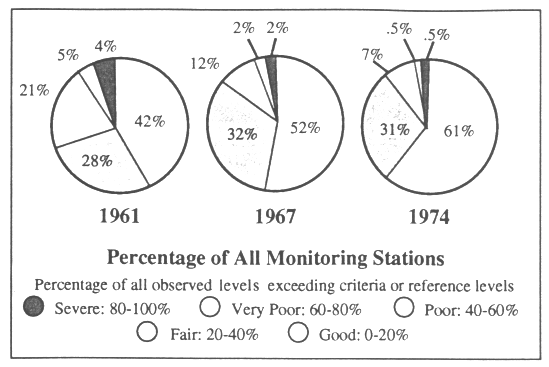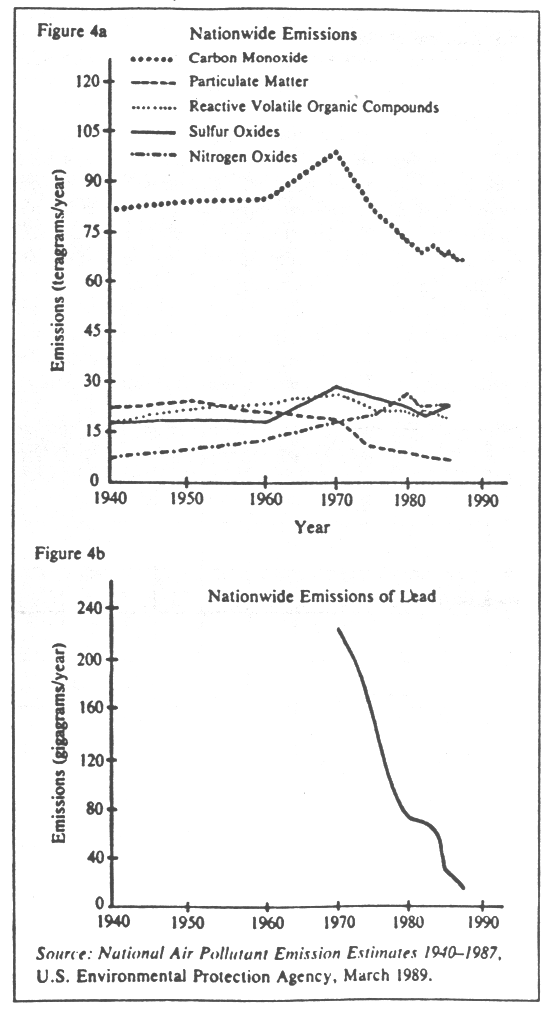Once again there is hysteria about there being too many people and too many babies being born. Television presents notables ranging from the late Andrei Sakharov to Dan Rather repeating that more people on earth mean poorer lives now and worse prospects for the future. The newspapers chime in. A typical editorial in the 3 June 1989 Washington Post says that “in the developing world…fertility rates impede advances in economic growth, health and educational opportunities.” Nobel-winner Leon Lederman says in his statement as candidate for the president of the American Association for the Advancement of Science that “overpopulation” is one of our “present crises” (2 June 1989 announcement). The president of NOW warns that continued population growth would be a “catastrophe” (Nat Hentoff in the Washington Post, 29 July 1989). The head of the Worcester Foundation for Experimental Biology calls for more funding for contraceptive research because of “Overpopulation, together with continuing deterioration of the environment .… “ (The Wall Street Journal, 14 August 1939).
And this is just a tiny sample of one summer. Erroneous belief about population growth has cost dearly. It had directed attention away from the factor that we now know is central in a country’s economic development: its economic and political system. Economic reforms away from totalitarianism and central economic planning in poor countries probably would have been faster and more widespread if slow growth was not explained by recourse to population growth. And in rich countries, misdirected attention to population growth and the supposed consequence of natural resource shortage has caused waste through such programs as synthetic fuel promotion and the development of airplanes that would be appropriate for an age of greater scarcity. Our antinatalist foreign policy is dangerous politically because it risks our being labeled racist, as happened when Indira Ghandi was overthrown because of her sterilization program. Furthermore, misplaced belief that population growth slows economic development provides support for inhumane programs of coercion and the denial of personal liberty in one of the most sacred and valued choices a family can make — the number of children that it wishes to bear and raise — in such countries as China, Indonesia, and Vietnam.
These ideas affect other public events, too. In 1973, Supreme Court Justice Potter Stewart’s vote in Roe v. Wade was influenced by this idea, according to Bob Woodward and Scott Armstrong: “As Stewart saw it, abortion was becoming one reasonable solution to population control” (quoted in Newsweek, 14 September 1987). And in 1989, when hearing the Webster case, Justice Sandra Day O’Connor again brought the idea of overpopulation into a hypothetical question she asked of Charles Fried, former solicitor-general: “Do you think that the state has the right to, if in a future century we had a serious overpopulation problem, has a right to require women to have abortions after so many children?” No matter how one feels about abortion — I personally feel that it should not be illegal, though I regret its occurrence — it seems better that unsound arguments should not be adduced in the discussion; such idea pollution tends to cost dearly in the long run.
Unlike the earlier period of rampaging worry following Earth Day 1970, however, it is now well-established scientifically that population growth is not the bogey that conventional opinion and the press believe it to be. In the 1980s a revolution occurred in scientific views toward the role of population growth in economic development. By now the economics profession has turned almost completely away from the previous view that population growth is a crucial negative factor in economic development. There is still controversy about whether population growth is even a minor negative factor in some cases, or whether it is beneficial in the long run. But there is no longer any scientific support for the earlier view which was the basis for the U.S. policy and then the policy of either countries.
For a quarter century our “helping” institutions misanalyzed such world development problems as starving children, illiteracy, pollution, supplies of natural resources, and slow growth. The World Bank, the State Department’s Aid to International Development (AID), the United Nations Fund for Populations Activities (UNFPA), and the environmental organizations have asserted that the cause is population growth — the population “explosion” or “bomb,” the “population plague” But for almost as long as this idea has been the core of U.S. theory about foreign aid, there has been a solid body of statistical evidence that contradicts this conventional wisdom about the effects of population growth — evidence which falsifies the ideas which support U.S. population policy toward less-developed countries.
The “official” turning point came in 1986 with the publication of a report by the National Research Council and the National Academy of Sciences (NRC-NAS), entitled Population Growth and Economic Development, which almost completely reversed a 1971 report on the same subject from the same institution. On the specific issue of raw materials that has been the subject of so much alarm, NRC-NAS concluded: “The scarcity of exhaustible resources is at most a minor constraint on economic growth… the concern about the impact of rapid population growth on resource exhaustion has often been exaggerated.” And the general conclusion goes only as far as “On balance, we reach the qualitative conclusion that slower population growth would be beneficial to economic development for most developing countries .…” That is, NRC-NAS found forces operating in both positive and negative directions, its conclusion does not apply to all countries, and the size of the effect is not known even where it is believed to be present. This is a major break from the past monolithic characterization of additional people as a major drag upon development across the board. This revolution in thought has not been reported in the press, however, and therefore has had no effect on public thought on the subject.
There now exist perhaps two dozen competent statistical studies covering the few countries for which data are available over the past century, and also of the many countries for which data are available since World War II. The basic method is to gather data on each country’s rate of population growth and its rate of economic growth, and then to examine whether -— looking at all the data in the sample together — the countries with high population growth rates have economic growth rates lower than average, and countries with low population growth rates have economic growth rates higher than average.
The clear-cut consensus of this body of work is that faster population growth is not associated with slower economic growth. On average, countries whose populations grew faster did not grow slower economically. That is, there is no basis in the statistics for the belief that faster population growth causes slower economic growth.
Additional powerful evidence comes from pairs of countries that have the same culture and history, and had much the same standard of living when they split apart after World War II — East and West Germany, North and South Korea, and China and Taiwan. In each case the centrally planned communist country began with less population “pressure,” as measured by density per square kilometer, than did the market-directed noncommunist country. And the communist and noncommunist countries in each pair also started with much the same birth rates and population growth rates.
The market-directed economies have performed much better economically than the centrally planned countries. Income per person is higher. Wages have grown faster. Key indicators of infrastructure such as telephones per person show a much higher level of development. And indicators of individual wealth and personal consumption, such as autos and newsprint, show enormous advantages for the market-directed enterprise economies compared to the centrally planned, centrally controlled economies. Furthermore, birth rates fell at least as early and as fast in the market-directed countries as in the centrally planned countries.
These data provide solid evidence that an enterprise system works better than does a planned economy. This powerful explanation of economic development cuts the ground from under population growth as a likely explanation. And under conditions of freedom, population growth poses less of a problem in the short run, and brings many more benefits in the long run, than under conditions of government planning of the economy.
One inevitably wonders: How can the persuasive common sense embodied in the Malthusian theory be wrong? To be sure in the short run an additional person — baby or immigrant — inevitably means a lower standard of living for everyone; every parent knows that. More consumers mean less of the fixed available stock of goods to be divided among more people. And more workers laboring with the same fixed current stock of capital means that there will be less output per worker. The latter effect, known as “the law of diminishing returns,” is the essence of Malthus’s theory as he first set it out.
But if the resources with which people work are not fixed over the period being analyzed, then the Malthusian logic of diminishing returns does not apply. And the plain fact is that, given some time to adjust to shortages, the resource base does not remain fixed. People create more resources of all kinds. When horse-powered transportation became a major problem, the railroad and the motor car were developed. When schoolhouses become crowded, we build new schools — more modern and better than the old ones.
As with man-made production capital, so it is with natural resources. When a shortage of elephant tusks for ivory billiard balls threatened in the last century, and a prize was offered for a substitute, celluloid was invented, followed by the rest of our plastics. Englishmen learned to use coal when trees became scarce in the sixteenth century. Satellites and fiber-optics (derived from sand) replace expensive copper for telephone transmission. And the new resources wind up cheaper than the old ones were. Such has been the entire course of civilization.
Extraordinary as it seems, natural-resource scarcity — that is, the cost of raw materials, which is the relevant economic measure of scarcity — has tended to decrease rather than to increase over the entire sweep of history. This trend is at least as reliable as any other trend observed in human history; the prices of all natural resources, measured in the wages necessary to pay for given quantities of them, have been falling as far back as data exist. A pound of copper — typical of all metals and other natural resources — now costs an American only a twentieth of what it cost in hourly wages two centuries ago, and perhaps a thousandth of what it cost three thousand years ago; the history since 1800 in the U.S. is shown in Figure l. And the price of natural resources has fallen even relative to consumer goods, as Figure 2 shows.


The most extraordinary part of the resource-creation process is that temporary or expected shortages — whether due to population growth, income growth, or other causes — tend to leave us even better off than if the shortages had never arisen, because of the continuing benefit of the intellectual and physical capital created to meet the shortage. It has been true in the past, and therefore it is likely to be true in the future, that we not only need to solve our problems, but we need the problems imposed upon us by the growth of population and income.
The idea that scarcity is diminishing is mind-boggling because it defies the commonsense reasoning that when one starts with a tinted stock of resources and uses some up, there is less left. But for all practical purposes there are no resources until we find them, identify their possible uses, and develop ways to obtain and process them. We perform these tasks with increasing skill as technology develops. Hence, scarcity diminishes.
The general trend is toward natural resources becoming less and less important with economic development. Extractive industries are only a very small part of a modern economy, say a twentieth or less, whereas they constitute the lion’s share of poor economies. Japan and Hong Kong are not at all troubled by the lack of natural resources, whereas such independence was impossible in earlier centuries. And though agriculture is thought to be a very important part of the American economy, if all of our agricultural land passed out of our ownership tomorrow, we would be the poorer by only about a ninth of one year’s Gross National Product. This is additional evidence that natural resources are less of a brake upon economic development with the passage of time, rather than an increasing constraint.
There is, however, one crucial “natural” resource which is more scarce — human beings. Yes, there are more people on earth now than in the past. But if we measure the scarcity of people the same way we measure the scarcity of economic goods — by the market price — then people are indeed becoming more scarce, because the price of labor time has been rising almost everywhere in the world. Agricultural wages in Egypt have soared, for example, and people complain of a labor shortage because of the demand for labor in the Persian Gulf. Just a few years after there was said to be a labor surplus in Egypt.
Nor does it make sense to reduce population growth because of the supposedly increasing pollution of our air and water. In fact, our air and water are becoming cleaner rather than dirtier, as Figure 3 and 4 show, wholly the opposite of conventional belief.


The most important and amazing demographic fact — the greatest human achievement in history, in my view — is the “recent” decrease in the world’s death rate. It took thousands of years to increase life expectancy at birth from just over twenty years to the high twenties. Then in just the last two centuries, life expectancy at birth in the advanced countries jumped from less than thirty years to perhaps seventy-five years. What greater event has humanity witnessed?
Then starting well after World War II, life expectancy in the poor countries has leaped upwards by perhaps fifteen or even twenty years since the 1950s, caused by advances in agriculture, sanitation, and medicine. Is this not an astounding triumph for humankind? It is this decrease in the death rate that is the cause of their being a larger world population nowadays than in former times.
Let’s put it differently. In the 19th century the planet Earth could sustain only one billion people. Ten thousand years ago, only four million could keep themselves alive. Now, five billion people are living longer and more healthily than ever before, on average. The increase in the world’s population represents our victory over death.
One would expect lovers of humanity to jump with joy at this triumph of human mind and organization over the raw forces of nature. Instead, many lament that there are so many people alive to enjoy the gift of life because they worry that population growth creates difficulties for development. And it is this misplaced concern that leads them to approve the inhumane programs of coercion and denial of personal liberty in one of the most precious choices a family can make — the number of children that it wishes to bear and raise.
Then there is the war-and-violence bugaboo. A typical recent headline is “Excessive Population Growth a Security Threat to U.S.,” invoking the fear of “wars that have their roots in the unrestrained growth of population.” This is reminiscent of the Hitlerian cry for “lebensraum” and the Japanese belief before World War II that their population density demanded additional land.
There is little scientific literature on the relation of population to war. But to the extent that there has been systematic analysis — notably the great study of war through the ages by Quincy Wright (1968), the work on recent wars by Nazli Choucri (1974), and a study of Europa between 1870 and 1913 by Gary Zuk (1935) — the data do not show a connection between population growth and political instability due to the struggle for economic resources. The purported connection is another of those notions that everyone (especially the CIA and the Defense Department) “knows” is true, and that seems quite logical, but has no basis in factual evidence.
The most important benefit of population size and growth is the increase it brings to the stock of useful knowledge. Minds matter economically as much as, or more than, hands or mouths. Progress is limited largely by the availability of trained workers. The main fuel to speed the world’s progress is the stock of human knowledge. And the ultimate resource is skilled, spirited, hopeful people, exerting their wills and imaginations to provide for themselves and their families, thereby inevitably contributing to the benefit of everyone.
Even the most skilled persons require, however, an appropriate social and economic framework that provides incentives for working hard and taking risks, enabling their talents to flower and come to fruition. The key elements of such a framework are respect for property, fair and sensible rules of the market that are enforced compatible with economic freedom. There is justice in such an approach, and wisdom, and the promise of unlimited economic and human development.
Which should be our vision? The doomsayers of the population control movement offer a vision of limits, decreasing resources, a zero-sum game, conservation, deterioration, fear, and conflict, calling for more governmental intervention in markets and family affairs. Or should our vision be that of those who look optimistically upon people as a resource rather than as a burden — a vision of receding limits, increasing resources and possibilities, a game in which everyone can win, creation, building excitement, and the belief that persons and firms, acting spontaneously in the search of their individual welfare, regulated only by rules of a fair game, will produce enough to maintain and increase economic progress and promote liberty.
And what should our mood be? The population restrictionists say we should be sad and worry. I and many others believe that the trends suggest joy and celebration at our newfound capacity to support human life — healthily, and with fast-increasing access to education and opportunity all over the world. I believe that the population restrictionists’ hand-wringing view leads to despair and resignation. Our view leads to hope and progress, in the reasonable expectation that the energetic efforts of humankind will prevail in the future, as they have in the past, to increase worldwide our numbers, our health, our wealth, and our opportunities.
Julian L. Simon teaches business administration at the University of Maryland. Her newest book is the Economic Consequences of Immigration (Basil Blackwell, 1989), Simon has authored over twelve books, including The Ultimate Resource (Princeton, PUP 1981). This article is reprinted with permission of the author.
References
Additional references may be found in my The Ultimate Resource (Princeton: PUP, 1931), and “Population Growth, Economic Growth, and Foreign Aid” in The Cato Journal 7, Spring-Summer, 1987.
Choucri, Nazli, Population Dynamics and International Violence, (Lexington, MA: Lexington Books, 1974).
Zuk, Gary, “National Growth and International Conflict; A Reevaluation of Choucri and North’s Thesis,” Journal of Politics (1985), 47: 269–281.










